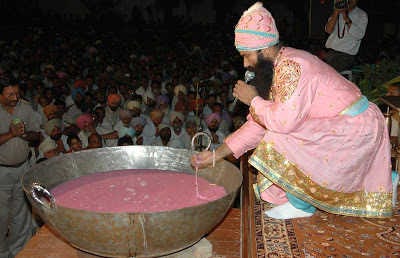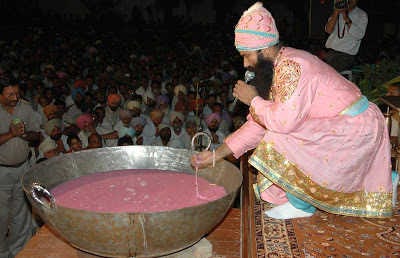Sirsa Sadh’s Sacrilege: A Tell-Tale Chronology of Conspiracy, Cover-Ups, and Badals’ Betrayal
How the Blasphemy of 2007 Unfolded into a Decade-Long Saga of Deceit, Delay, and Denied Justice.
Preface: A Panthic Crisis Unfolds
The Sikh Panth finds itself at a critical juncture, where past wounds remain unhealed, and new fault lines continue to emerge. The December 2 Hukamnama from Sri Akal Takht Sahib sought to reassert the Panthic authority, but its implementation remains in question. The seven-member committee constituted by the Akal Takht to oversee crucial matters struggles against political encroachments. Meanwhile, the Shiromani Akali Dal (SAD) presses ahead with its fresh membership enrollment, seemingly in contravention of the Akal Takht’s directive, raising concerns about its defiance of Panthic discipline. In the midst of this turmoil, the fate of Giani Harpreet Singh, the now-suspended Jathedar of Takht Damdama Sahib, remains uncertain.
As the debate over Panthic leadership and accountability rages on, we have taken a step back to revisit the blasphemous act that ignited this prolonged crisis—the sacrilegious impersonation of Guru Gobind Singh Ji by the Dera Sacha Sauda chief on May 13, 2007, at Salabatpura. Today, a live-streamed video was recorded in Punjabi, retracing the origins of this painful episode and examining its far-reaching consequences.
This article serves merely as a concise English summary of the events for those who do not understand Punjabi. For a deeper, more comprehensive account, we urge readers to watch the full video and engage with its insights. Your comments and reflections are most welcome. Let us, together, seek the truth and uphold the dignity of Sri Guru Granth Sahib Ji and the Sikh Panth.
Of Sirsa Sadh Sacrilege: Conspiracy to Cover-Up, and Badals Befuddling the Matter
The pain and reverence that Sikhs hold for Sri Guru Granth Sahib Ji, the eternal Guru, is beyond mere sentiment; it is a sacred covenant of devotion, a spiritual lifeline that embodies the very essence of Sikh identity. To wound this sanctity is to strike at the soul of an entire people. The events that began on 13 May 2007 with Gurmeet Ram Rahim Singh’s blasphemous imitation of Guru Gobind Singh Ji at Salabatpura village of Bathinda district, and the ensuing cover-up orchestrated under the watch of Punjab’s power elite, especially the Badals, have left deep scars. What should have been a straightforward case of punishing the guilty has instead turned into a saga of delay, deceit, and political expediency.
The timeline of this shameful episode, extending from 2007 to 2017, indeed till the present, is a testimony to the failure of justice under Sukhbir Singh Badal, who, as Deputy Chief Minister and Home Minister of Punjab, seemed more invested in electoral mathematics than in upholding Sikh dignity. The judicial system, though slow, is now finally working towards holding the perpetrators accountable. The question remains—will justice, long delayed, be denied?
May 13, 2007: The Blasphemous Impersonation at Salabatpura
The firestorm began when Gurmeet Ram Rahim Singh, head of Dera Sacha Sauda, dared to dress as Guru Gobind Singh Ji, imitating the Amrit Sanchar ceremony. This was nothing short of a direct provocation, an outrageous act of sacrilege meant to undermine Sikh traditions and challenge the Guru’s sovereignty. The Dera Chief, with his questionable past and dubious spiritual claims, had already amassed a following through deceit and theatrics. This act, however, crossed all limits.
May 14-16, 2007: Punjab Erupts in Protest
The Sikh Panth responded with rightful fury. Massive protests erupted across Punjab, with thousands taking to the streets to demand action against the Dera Chief. The Akal Takht, the supreme temporal authority of Sikhs, came under immense pressure of the broader Sikh Sangat to act decisively.
May 17, 2007: Blood on the Streets, Hukamnama from Akal Takht
As tempers soared, violence broke out. One Sikh was martyred near Sunam in a clash with Dera followers, and at least 22 were injured in sporadic violence. Dera properties were attacked across Punjab, and Sikh organizations intensified their demand for legal action.
Amidst this, the Akal Takht, led by Jathedar Joginder Singh Vedanti, issued a five-point hukamnama:
Complete social boycott of the Dera and its followers.
Empowering the SGPC to monitor and counter Dera activities.
Ultimatum to the Punjab Government to act by May 20, failing which Sikhs would be compelled to take matters into their own hands.
Warning against inaction.
Decision to lock Dera properties across Punjab.
This was a historic moment—the Khalsa Panth was asserting its sovereignty, yet the response from the ruling Badals remained meek and calculated.
May 20, 2007: The FIR That Went Nowhere
An FIR (No. 262) was finally registered against Ram Rahim under Section 295-A IPC at Kotwali police station, Bathinda. The Badal-led Punjab government, however, was already scripting its betrayal—offering empty assurances while ensuring that legal proceedings remained a mere formality.
June 26, 2007: Akal Takht Rejects Ram Rahim’s ‘Apology’
In a desperate attempt to douse Sikh anger, Ram Rahim issued a so-called ‘apology’, but the Akal Takht, with Jathedar Joginder Singh Vedanti as its Jathedar, rejected it outright. This was not a case of mere hurt sentiments; it was an affront to Sikh sovereignty. The Panth’s position remained firm—he must face trial and punishment.
June 27, 2007: Punjab Government’s Prosecution Nod – A Cosmetic Move?
Under immense pressure, the Punjab Government sanctioned Ram Rahim’s prosecution, a legal necessity for offences under section 295-A IPC. But was it a sincere move or merely a prelude to a systemic and strategic delay? With Sukhbir Singh Badal controlling the police as Home Minister, every action taken seemed to be calculated election-time posturing, rather than an honest effort to bring the culprit to justice and practically nothing happened till the Vidhan Sabha elections of 2012.
2012: Badals and the Pre-Election Whitewash
As Punjab headed into Assembly elections, the Badal government struck its most treacherous blow. On January 27, 2012, the Punjab Police filed a cancellation report in the Bathinda court, effectively absolving Ram Rahim. This, just days before the state went to polls!
This was an outright betrayal of Sikh sentiments. The Dera’s voter base had been courted, justice had been bartered for votes, and Sukhbir Badal stood exposed—a leader who claimed to be the torchbearer of Sikh interests but was secretly pandering to anti-Sikh forces.
April 2, 2012: Judiciary Refuses to Play Along
The Chief Judicial Magistrate rejected the cancellation report, proving that the case had merit. This was a rare moment of accountability, but the Punjab government continued to stall and obstruct the case.
August 2014: Ram Rahim Gets ‘Relief’—Justice Denied Yet Again
In August 2014, the Bathinda Sessions Court discharged Ram Rahim, citing failure to file charges within three years. This was yet another technicality orchestrated by the Bdal Government, ensuring that justice remained elusive.
September 24, 2015: Controversial Pardon Granted Without Personal Appearance
On September 24, 2015, the Akal Takht, under the leadership of Jathedar Giani Gurbachan Singh, under tremendous pressure from the Badals, issued a pardon to Dera Sacha Sauda chief Gurmeet Ram Rahim Singh for his 2007 blasphemous impersonation of Guru Gobind Singh Ji. Notably, the Dera chief did not present himself before the Akal Takht to seek forgiveness; instead, he submitted a half-hearted written apology. This pardon was granted without imposing any formal punishment, a decision that sparked widespread controversy and discontent within the Sikh community.
June-October 2015: From Bargari to Kotkapura—Sacrilege and Bloodshed
The fire of betrayal spread further in 2015 when a copy of Sri Guru Granth Sahib Ji was stolen in Burj Jawahar Singh Wala on June 1, 2015. This led to the horrific events of October 12, 2015, when over 110 torn pages of Sri Guru Granth Sahib were found scattered in Bargari village, in Faridkot district.
Sikhs rose in protest, but the Badal regime responded with bullets. On October 14, 2015, Punjab Police fired on peaceful protesters in Kotkapura, killing two Sikhs and wounding many.
October 16, 2015: The U-Turn – Akal Takht Revokes Ram Rahim’s Pardon
Adding insult to injury, the SGPC-dominated Akal Takht had, as stated ebfore, initially pardoned Ram Rahim on September 24, 2015, sparking massive outrage. It was only after mass protests and the police firing at Kotkapura and Behbal Kalan that the pardon was revoked on October 16, 2015.
Who had orchestrated this shameful flip-flop? Who had attempted to whitewash the crimes of a blasphemer? The answers lead back to Sukhbir Singh Badal and his coterie, whose sole focus remained on political survival over Sikh interests.
Waiting for Conclusion: Can There Be Closure Without Justice?
The judicial process is now catching up, with cases reopened and criminal trials inching forward. But the damage has been immeasurable. The betrayal by those who pretended to be Panthic leaders but instead shielded enemies of the faith is etched in history.
The Dera Chief will one day be punished, but what about those who betrayed the trust of the Sikh people? The real culprits in political corridors must also face their reckoning. The Guru’s justice is inevitable; only time will tell whether earthly courts will deliver their part before it’s too late.





਼ਰਾਜ ਸੱਤਾ ਤੇ ਕਾਬਜ਼ ਰਹਿਣ ਲਈ ਸਿੱਖੀ ਸਰੂਪ ਵਿੱਚ ਇੱਕ ਪ੍ਰੀਵਾਰ ਵੱਲੋਂ ਕੌਮ ਵਿਰੁੱਧ ਕਮਾਏ ਧ੍ਰੋਹ ਕਾਰਨ ਵਾਪਰੇ ਦੁਖਾਂਤਾਂ ਕਰਕੇ ਸਿੱਖ ਕੌਮ ਦੀ ਪੀੜਾ ਦੇ ਇਹ ਭਾਵੁਕ ਮਾਮਲੇ ਹਨ ਜਿਨ੍ਹਾਂ ਨੂੰ ਕਦੇ ਵੀ ਭੁਲਾਇਆ ਨਹੀਂ ਜਾ ਸਕਦਾ ਅਤੇ ਇਸ ਅੱਗ ਦਾ ਸੇਕ ਇਤਿਹਾਸ ਦੇ ਪੰਨਿਆਂ ਵਿੱਚੋਂ ਹਮੇਸ਼ਾਂ ਆਉਂਦਾ ਰਹੇਗਾ। ਅੱਜ ਵੀ ਉਸ ਪ੍ਰੀਵਾਰ ਅਤੇ ਉਸ ਦੇ ਚਮਚਾਗਿਰਾਂ ਵੱਲੋਂ ਸਾਜ਼ਿਸ਼ਾਂ ਗੁੰਦਣ ਅਤੇ ਗੁਮਰਾਹ ਕਰਨ ਵਿੱਚ ਕੋਈ ਕਸਰ ਨਹੀਂ ਛੱਡੀ ਜਾ ਰਹੀ ਨਤੀਜੇ ਵਜੋਂ ਧੂਏਂ ਦੇ ਬੱਦਲ ਏਨੇਂ ਸੰਘਣੇ ਹੋ ਚੁੱਕੇ ਹਨ ਕਿ ਆਉਣ ਵਾਲਾ ਭਵਿੱਖ ਵੀ ਇਸੇ ਦੀ ਭੇਟਾ ਚੜਦਾ ਵਿਖਾਈ ਦੇ ਰਿਹਾ ਹੈ।
ਸਿੱਧੂ ਸਾਬ ਇਨ੍ਹਾਂ ਮੁੱਦਿਆਂ ਨੂੰ ਪੇਂਡੂ ਸਮਾਜ ਵਿੱਚ ਹੋਰ ਪ੍ਰਪੱਕਤਾ ਨਾਲ ਪ੍ਰਚਾਰਨ ਦੀ ਸਖ਼ਤ ਜ਼ਰੂਰਤ ਹੈ ਅਤੇ ਤੁਸੀਂ ਆਪਣਾ ਯੋਗਦਾਨ ਵਧੀਆ ਢੰਗ ਨਾਲ ਪਾ ਕੇ ਚੇਤਨਾਂ ਪੈਦਾ ਕਰਨ ਦਾ ਸੁਚੱਜਾ ਉਪਰਾਲਾ ਕਰ ਰਹੇ ਹੋ। ਬੇਨਤੀ ਹੈ ਕਿ ਇਸ ਬਾਰੇ ਆਪਣੀ ਰਾਏ ਵੀ ਅੰਕਿਤ ਕਰਨ ਦੀ ਖੇਚਲ ਕਰਿਆ ਕਰੋ ਜੀ।
ਧੰਨਵਾਦ ਸਹਿਤ
ਨਿਸ਼ਾਨ ਸਿੰਘ ਕਾਹਲੋਂ
Dear S KBS, you’ve covered the topic in a very succinct way. The leaders of the Panth have been betraying it for their personal gains time and again. But the Panth has come out victorious every time. The outrageous acts of Nirankari Mandal had posed a big challenge to the Panth leading to the decades of trouble in Punjab. By the grace of Sri Guru Granth Sahab ji, the Khalasa Panth stands vindicated. Similarly, Ram Rahim, in spite of open support from the governments, has no sympathy among the people of any community. He stands convicted and condemned.
With the guiding force of Guru’s word, the Panth stands to be victorious over all hurdles, conspiracies and challenges. Because Khalsa belongs to Waheguru and the Victory, too, is His. ਵਾਹਿਗੁਰੂ ਜੀ ਕਾ ਖਾਲਸਾ ਵਾਹਿਗੁਰੂ ਜੀ ਕੀ ਫ਼ਤਹਿ!!